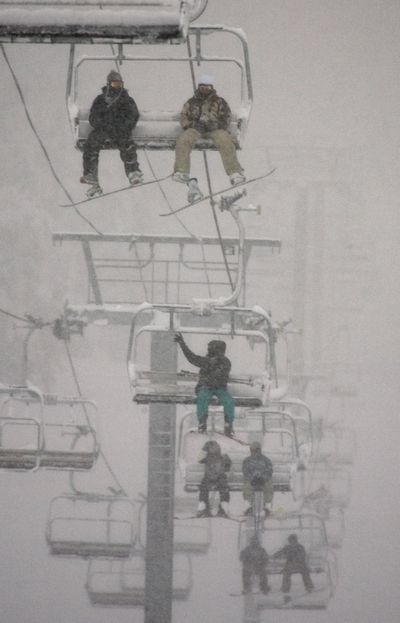Argument on beacons starts again
Some want climbers to carry signal device

PORTLAND – When a rescue team came upon Luke Gullberg’s body at the top of a Mount Hood glacier and tried to figure out what had become of his climbing partners, they looked up at a forbidding rise of ice and snow.
They saw no sign of Katie Nolan and Anthony Vietti on the 1,500-foot Reid headwall, no gear in bright color standing out from the monochrome, no trail. And they heard no radio signal.
Had Nolan and Vietti rented a $5 locator beacon and had they been able to activate it after whatever misfortune ended their climb on Dec. 12, the searchers below might have been able to pinpoint their location. The two are presumed buried beneath several feet of snow and ice.
It’s the second time in three years that a search-and-rescue operation on the 11,239-foot mountain has failed to turn up climbers who went up the mountain without signaling devices and got into deadly trouble.
So, politicians, rescue crews, mountaineers and others are debating once again whether to require such climbers to carry locator beacons.
“People are dying for no reason,” said Jim Bernard, a Clackamas County commissioner and longtime climber who said he had been up Mount Hood several times. “We need to find a way to protect them and we need to find a way to protect the people’s resources.”
A bill to require Mount Hood climbers to carry beacons on winter expeditions failed in the Oregon Legislature in 2007. Bernard hopes the Legislature will revisit the question, or the state’s congressional delegation will take an interest.
He said the county commission will take another stab at a requirement that climbers carry locator beacons. Commissioners have previously run into a restriction on the kind of agreements they could make with the U.S. Forest Service, which manages the mountain.
The stiffest opposition to requiring beacons comes from the elite mountaineers.
Beacons can be useful, but climbers should have the freedom to weigh the safety benefits of any piece of equipment against its weight or how it might impede their agility on a mountain that can rain down ice and rock at any moment, said Steve Rollins of Portland Mountain Rescue, a leader of Mount Hood search-and-rescue operations.
Mountaineers also warn that requiring the devices can lead some climbers to take undue risk, figuring on a rescue if they get into trouble, and that beacons aren’t always going to lead to rescues.
Even as they found Gullberg’s body, Rollins said, the snowpack beneath the feet of the members of the mountain rescue team was “shooting cracks” and making a “whumping” sound.
It was, he said, Mother Nature screaming about avalanche danger. That only rose during the search.
“I do not believe that we could have gotten there even if we had a beacon,” Rollins said.
One state official argues against such a requirement on grounds of personal liberty.
“The land is public, and I’m not a real big fan of mandating what people have to take with them when they want to go for a walk,” said Georges Kleinbaum, search-and-rescue coordinator for the Oregon Office of Emergency Management.
As many as 10,000 climbers attack Mount Hood each year, based on the free permits for which they self-register.
Even if a beacon signal doesn’t lead to a rescue, Sheriff Joe Wampler of Hood River County said, it would tell authorities where eventually to find the body, often a concern of relatives. He’s calling for beacons to be required above the timberline throughout Oregon.
Charley Shimanski of Evergreen, Colo., president of the national Mountain Rescue Association, said the group knows of no requirement anywhere in the country for beacons or any other safety equipment. At Mount McKinley in Alaska, he said, climbers have to sit through an instructional video before they go up.
There are a variety of locator devices, sized between cell phones and TV remotes. The $5 Mount Hood rental beacon is older technology, and rescuers wouldn’t tune in until somebody is reported overdue. Outdoors stores sell devices that use GPS and satellite technology to send immediate distress signals. They can weigh 5 to 9 ounces and cost up to $400.
In 2007, the Oregon House passed a bill to require Mount Hood climbers in winter to carry locators. It passed the House but died in the Senate.